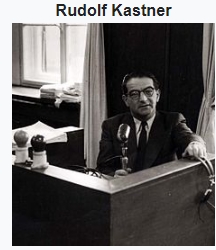In 1944, a deal with Eichmann. In 2024, same deal with Hamas?
By Lev Tsitrin
In 1944,Rudolf Kastner rescued 1.684 Hungarian Jews from the Nazis. In 1957, he was gunned down — by a Jew — in Tel Aviv.
 Why? Well, as we all know, the devil is in the details. Kastner, one of the leaders of Hungarian Jewish community, saved those people by negotiating a payment to Eichmann of $1,000 per head — a price that could not be afforded by many, but clearly worth it for those who could.
Why? Well, as we all know, the devil is in the details. Kastner, one of the leaders of Hungarian Jewish community, saved those people by negotiating a payment to Eichmann of $1,000 per head — a price that could not be afforded by many, but clearly worth it for those who could.
But this is for paying money to the chief architect of the Holocaust that Kastner was assassinated. He also payed another, much less acceptable price: his silence on the German aims in deporting Hungary’s Jews after Germany occupied the country in March, 1944.
Two escapees from Auschwitz wrote a detailed report on its extermination machinery to alert Jewish communities and the Allies of the need to resist the wholesale annihilation of the Jews brought there — which by extension, must have been occurring in other places, too. A copy was in Kastner’s hands, yet he did not alert Hungarian communities of the need to hide and resist transportation. He did not tell Hungarian Jews what awaited those on the transports, ensuring smooth and resistless extermination of 560,000 Hungarian Jews. According to Wikipedia, when interviewed by a sympathizer in 1960, “Eichmann said that Kasztner “agreed to help keep the Jews from resisting deportation – and even keep order in the collection camps – if I would close my eyes and let a few hundred or a few thousand young Jews emigrate to Palestine. It was a good bargain.” As one of the authors of the Auschwitz Report Rudolf Vrba put it, “Kasztner paid for those 1,684 lives with his silence.”
Fast forward to the present — at least to the last weekend in which a reported half a million Israelis massed on the streets in the wake of Hamas’ murder of six hostages to clamor for another “good bargain” — a good bargain for Hamas, that is: the release of the sixty-some live hostages, and the remains of the dead ones for Hamas’ victory in the war — i.e. Israel’s complete withdrawal from Gaza and the end to the war so Hamas could get back on its feet, again engaging in terrorism. To the protestors — if they think at all, rather than just feel — it is a price worth paying: an unknown number of the future victims of Hamas terror in exchange for seeing the happiness of a hundred Israeli families reunited with their loved ones.
The question is, how is this not a modern-day Kastner’s deal with Eichmann? I realize that the families of hostages go through a hell, and this suggestion is cruel in the extreme — but can they take a pen and write on a piece of paper a number — the acceptable number of Israelis who would be killed so they have the happiness of seeing their loved ones come back from the Gaza captivity?
Yes, it is a very cruel arithmetic — and yet, in the case of the Gilad Shalit deal, 1,200 Israelis killed on October 7, plus some 700 soldiers killed in the war so far is the price of Shalit family’s happiness. In Kastner deal, the ratio of saved to perished was around 1 to 300; in Shalit deal, it was over six times as much. I wonder, why don’t we hear from the Shalits? Are they getting interviewed by the press? Are they pleased with the price of Gilad’s freedom?
In 1944, there may have been no other way to survive than to pay ransom to Eichmann. Back than, there could only be a scramble to save oneself, come what may. But this is 2024, not 1944. Jews have a state, and an army to defend it. So why are there half a million would-be Kastners taking to Israel’s streets? Isn’t this the time for unity and strength, and not for panicky attempts to find safety for some — paying for it with the mortal danger for all?